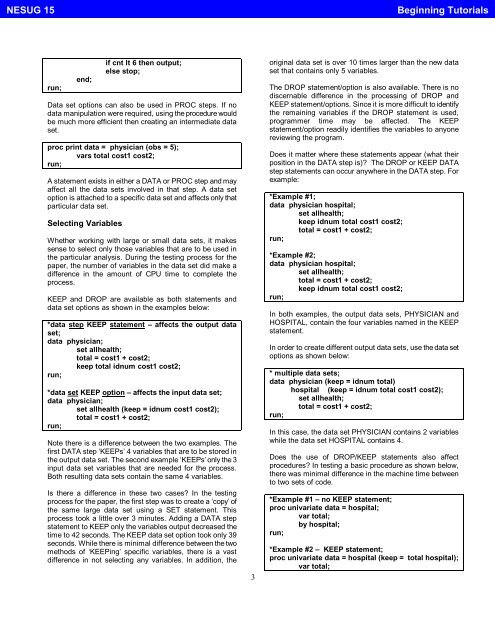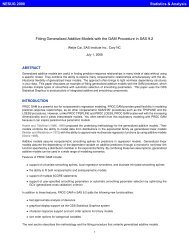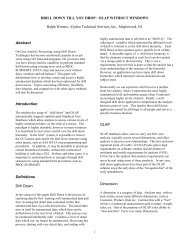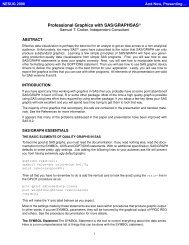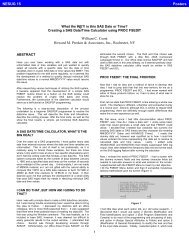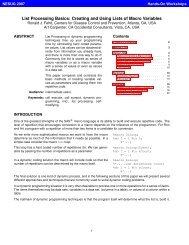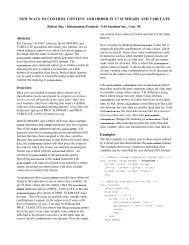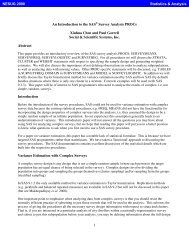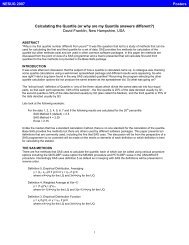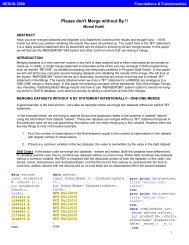Tips for Manipulating Data - NESUG
Tips for Manipulating Data - NESUG
Tips for Manipulating Data - NESUG
Create successful ePaper yourself
Turn your PDF publications into a flip-book with our unique Google optimized e-Paper software.
<strong>NESUG</strong> 15Beginning Tutorialsrun;end;if cnt lt 6 then output;else stop;<strong>Data</strong>setoptionscanalsobeusedinPROCsteps.Ifnodata manipulation were required, using the procedure wouldbe much more efficient then creating an intermediate dataset.proc print data = physician (obs = 5);vars total cost1 cost2;run;A statement exists in either a DATA or PROC step and mayaffect all the data sets involved in that step. A data setoption is attached to a specific data set and affects only thatparticular data set.Selecting VariablesWhether working with large or small data sets, it makessense to select only those variables that are to be used inthe particular analysis. During the testing process <strong>for</strong> thepaper, the number of variables in the data set did make adifference in the amount of CPU time to complete theprocess.KEEP and DROP are available as both statements anddata set options as shown in the examples below:*data step KEEP statement – affects the output dataset;data physician;set allhealth;total = cost1 + cost2;keep total idnum cost1 cost2;run;*data set KEEP option – affects the input data set;data physician;set allhealth (keep = idnum cost1 cost2);total = cost1 + cost2;run;Note there is a difference between the two examples. Thefirst DATA step ‘KEEPs’ 4 variables that are to be stored inthe output data set. The second example ‘KEEPs’ only the 3input data set variables that are needed <strong>for</strong> the process.Both resulting data sets contain the same 4 variables.Is there a difference in these two cases? In the testingprocess <strong>for</strong> the paper, the first step was to create a ‘copy’ ofthe same large data set using a SET statement. Thisprocess took a little over 3 minutes. Adding a DATA stepstatement to KEEP only the variables output decreased thetime to 42 seconds. The KEEP data set option took only 39seconds. While there is minimal difference between the twomethods of ‘KEEPing’ specific variables, there is a vastdifference in not selecting any variables. In addition, the3original data set is over 10 times larger than the new dataset that contains only 5 variables.The DROP statement/option is also available. There is nodiscernable difference in the processing of DROP andKEEP statement/options. Since it is more difficult to identifythe remaining variables if the DROP statement is used,programmer time may be affected. The KEEPstatement/option readily identifies the variables to anyonereviewing the program.Does it matter where these statements appear (what theirposition in the DATA step is)? The DROP or KEEP DATAstep statements can occur anywhere in the DATA step. Forexample:*Example #1;data physician hospital;set allhealth;keep idnum total cost1 cost2;total = cost1 + cost2;run;*Example #2;data physician hospital;set allhealth;total = cost1 + cost2;keep idnum total cost1 cost2;run;In both examples, the output data sets, PHYSICIAN andHOSPITAL, contain the four variables named in the KEEPstatement.In order to create different output data sets, use the data setoptions as shown below:* multiple data sets;data physician (keep = idnum total)hospital (keep = idnum total cost1 cost2);set allhealth;total = cost1 + cost2;run;In this case, the data set PHYSICIAN contains 2 variableswhile the data set HOSPITAL contains 4.Does the use of DROP/KEEP statements also affectprocedures? In testing a basic procedure as shown below,there was minimal difference in the machine time betweento two sets of code.*Example #1 – no KEEP statement;proc univariate data = hospital;var total;by hospital;run;*Example #2 – KEEP statement;proc univariate data = hospital (keep = total hospital);var total;


